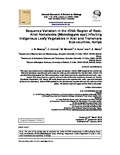| dc.contributor.author | Mwangi, J. M. | |
| dc.contributor.author | Gichuki, C . | |
| dc.contributor.author | Wanjohi, W. | |
| dc.contributor.author | Runo, S. | |
| dc.contributor.author | Maina, P. K. | |
| dc.date.accessioned | 2018-08-15T07:08:59Z | |
| dc.date.accessioned | 2020-02-07T06:31:08Z | |
| dc.date.available | 2018-08-15T07:08:59Z | |
| dc.date.available | 2020-02-07T06:31:08Z | |
| dc.date.issued | 2016 | |
| dc.identifier.uri | http://repository.must.ac.ke/handle/123456789/983 | |
| dc.description.abstract | Place and Distribution of Study:Nematology Laboratory, Kenyatta University and International Livestock Research Institute (ILRI) Laboratories, Nairobi, between March 2009 to September 2011.Samples were obtained from two sites; Kisii and Trans-mara sub-counties. From each selected site; 10 farms which grew ILVs were ran
domly sampled. From each farm 10 plants of each ILV infected by Root knot nematodes were randomly selected. They were uprooted together with the surrounding soil and transported to the laboratory.In the laboratory female second-stage juveniles (J2) were extracted and used for genomic DNA isolation and sequencing. PCR
amplifications of the extracted DNA was carried out for each isolate using primers: SSU18A (5’-AAAGATTAAAGCCATGCATG-3’) and SSU26R (5’-CATTCTTGGCAAATGCTTTCG-3’). Double stranded DNA were sequenced by cycle sequencing with Big Dye 3.0 Terminator cycle sequencing kit and analyzed with an ABI 310 Gene Analyzer. Sequences were determined on one strand using the M13 forward primer. Sequence information was assembled using sequencer 4.1. Alignments were performed using ClustalW. Results:All the three major species identified, namely Meloidogyne arenaria, M. javanica and M. incognita amplified using SSUrRNA produced a single PCR product of 700 bp and 11 sequences obtained that were compared with nucleotide sequences in the Gene bank using the BLAST Software to determine similarities. Several sequences of Meloidogyne nematodes (5 S ribosomal
RNA) were identified with regions that matched with the obtained sequences.The nearly complete 5S rDNA sequences obtained from the 11 sequences varied from 675 to 692 base pairs.Conclusion: The selected primers can be used for determining variation in the rDNA region in RKN infecting ILVs in Kenya. | en_US |
| dc.publisher | SCIENCEDOMAIN internationa | en_US |
| dc.subject | DNA sequencing; | en_US |
| dc.subject | Indigenous leafy vegetables ; | en_US |
| dc.subject | Root - knot nematodes; | en_US |
| dc.subject | PCR . | en_US |
| dc.title | Sequence Variation in the rDNA Region of Root - Knot Nematodes ( Meloidogyne spp) Infecting Indigenous Leafy Vegetables in Kisii and Transmara Sub - counties, Kenya | en_US |
| dc.type | Article | en_US |

